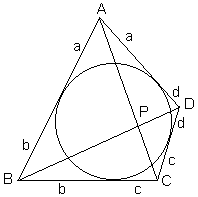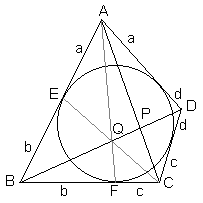Ceva in Circumscribed Quadrilateral

|
Let ABCD be a quadrilateral circumscribed around a circle. Denote the lengths of tangents from the vertices A, B, C, and D to the circle as a, b, c, d, respectively. Finally, let P be the point of intersection of the diagonals AC and BD. Then we have
| (1) | AP/PC = a/c. |
Proof
Let E be the point of tangency of the incircle on side AB and F be the point of tangency on side BC.

|
By Brianchon's theorem the lines AF, BP, and CE concur at, say, point Q. Apply Ceva's theorem to ΔABC:
| AP/PC · CF/FB · BE/EA = 1. |
In other words,
| AP/PC · c/b · b/a = 1. |
And, finally,
| AP/PC = a/c. |
Remark
Darij Grinberg has gracefully noted that the theorem has been established by more elementary means elsewhere.
Menelaus and Ceva
- The Menelaus Theorem
- Menelaus Theorem: proofs ugly and elegant - A. Einstein's view
- Ceva's Theorem
- Ceva in Circumscribed Quadrilateral
- Ceva's Theorem: A Matter of Appreciation
- Ceva and Menelaus Meet on the Roads
- Menelaus From Ceva
- Menelaus and Ceva Theorems
- Ceva and Menelaus Theorems for Angle Bisectors
- Ceva's Theorem: Proof Without Words
- Cevian Cradle
- Cevian Cradle II
- Cevian Nest
- Cevian Triangle
- An Application of Ceva's Theorem
- Trigonometric Form of Ceva's Theorem
- Two Proofs of Menelaus Theorem
- Simultaneous Generalization of the Theorems of Ceva and Menelaus
- Menelaus from 3D
- Terquem's Theorem
- Cross Points in a Polygon
- Two Cevians and Proportions in a Triangle, II
- Concurrence Not from School Geometry
- Two Triangles Inscribed in a Conic - with Elementary Solution
- From One Collinearity to Another
- Concurrence in Right Triangle
- R. Honsberger, More Mathematical Morsels, MAA, 1991, p. 61.

References

|Contact| |Front page| |Contents| |Generalizations| |Geometry|
Copyright © 1996-2018 Alexander Bogomolny
73511079
